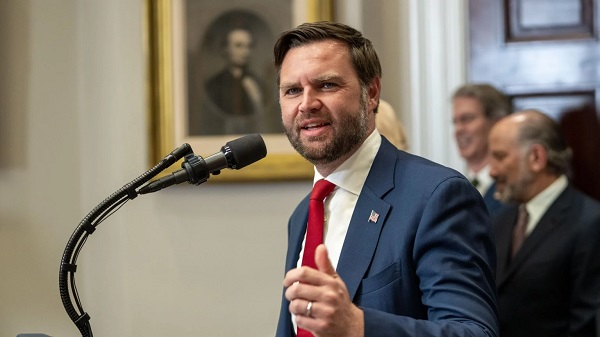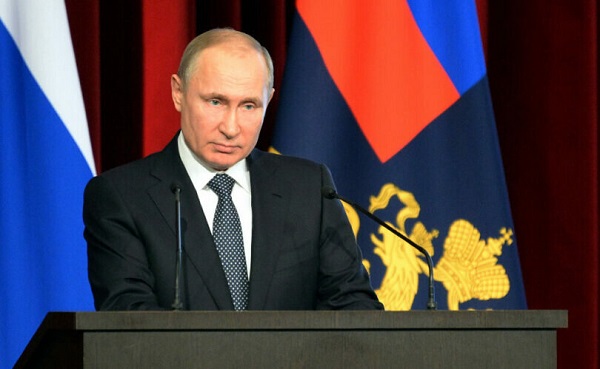conflict
Putin Threatens Nuclear War As West Wades Even Deeper Into Russia-Ukraine Conflict
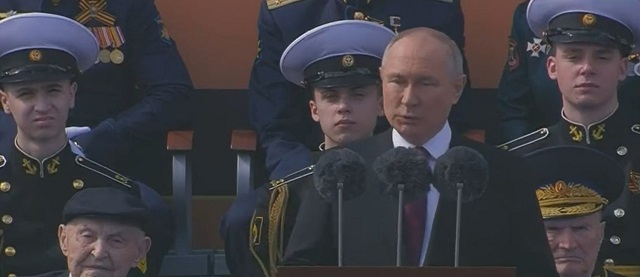
From the Daily Caller News Foundation
By Jake Smith
Russian President Vladimir Putin on Wednesday lowered the threshold for the use of nuclear weapons against the West, marking yet another escalation in an already drawn-out war that has cost hundreds of thousands of lives and shown no signs of ending.
Putin announced during a meeting with the Russian Security Council on Wednesday that the country’s nuclear doctrine was being expanded to include the possible use of such weapons against other nations with nuclear capabilities, should they support a non-nuclear state — such as Ukraine — in a heavy missile attack against Russia. The warning comes amid President Joe Biden’s announcement on Thursday of an additional $8 billion in military aid to Ukraine and reports that Western nations are considering allowing Kyiv to use their long-range weapons to strike deep inside Russian territory.
Ben Friedman, policy director at Defense Priorities, told the Daily Caller News Foundation that Putin is likely “bluffing,” but it is not worth the risk for the U.S. to allow Ukraine to make such a move.
“I think the odds of Russia using a nuclear weapon in response to one of these hypothetical strikes are pretty low. But how much do you want to gamble on that? How much do you want to bet that Putin is bluffing? I’d say not very much,” Friedman told the DCNF. “You want to be very cautious. The U.S. has no security interest in taking those sorts of risks in a conflict that could escalate to a larger war, even a nuclear exchange in a worst-case scenario.”
Putin said during the security meeting that the nuclear doctrine was being updated because of an “emergence of new sources of military threats and risks for Russia and our allies,” according to multiple reports.
“The updated version of the document proposes that aggression against Russia by any non-nuclear-weapon state, but with the participation or support of a nuclear-weapon state, should be considered as a joint attack on the Russian Federation,” Putin told the council on Wednesday, noting that the conditions to launch nuclear weapons would be based on “reliable information about a massive launch of aerospace attack means and their crossing of our state border,” according to the Post.
“We reserve the right to use nuclear weapons in the event of aggression against Russia and Belarus,” Putin said.
Officials from the White House and State Department told the DCNF they were “not surprised” By Putin’s warning.
“Russia has been signaling its intent to update its nuclear doctrine for several weeks,” a State Department spokesperson told the DCNF. “However, Putin’s public comments highlight Russia’s attempts to use irresponsible nuclear rhetoric and employ coercive nuclear signaling as it has done against Ukraine for more than two years.”
Moscow’s threat of using nuclear weapons has been frequently raised as the U.S. and Europe continue to throw their support behind Ukraine’s defense against Russia’s invasion, which began in 2022 and has shown no signs of stopping. Putin has issued such warnings specifically over the West’s indirect involvement in the war, which has largely come in the form of military aid to Ukraine.
The U.S. alone has allocated over $55 billion worth of military assistance to Ukraine since 2022, while European partners have committed roughly $46 billion in the same time frame.
But certain rules and regulations have been imposed on the military aid to Ukraine, particularly around how weapons can be used to strike Russia. For much of the war, Western nations restricted Ukraine from using the weapons to strike inside Russia, although that ban was recently lifted to allow Ukrainian forces to launch attacks against Russia’s border region.
Ukraine wants the West to make further allowances on weapons use, however. Kyiv argues that it should be allowed to use U.S. and European-provided long-range missiles to hit targets deep inside of Russian territory, a move which the U.S. has been wary of due to escalatory risks with Moscow.
But now a number of nations are signaling that they will allow Ukraine to use long-range systems to strike Russia, including Britain and France, though they want the U.S. to give the green light first — and some European partners have become frustrated with the delay for approval.
“It would be really good to stop the delays. And I think that the restrictions on the use of weapons should be lifted,” Denmark Prime Minister Mette Frederiksen told Bloomberg on Monday.
Though the U.S. and West have bolstered Ukraine’s military efforts over the last two years through extensive funding measures, it has done little to change the course of the conflict. Ukraine is suffering from a worsening manpower shortage as its troops are killed in combat along the Eastern line of the war, and has been forced to retreat from regions along that front as Russian forces advance.
Russia has made small territorial gains along the Eastern front, but it has come at the cost of hundreds of thousands of soldiers’ lives and hundreds of billions of dollars in spending. Some Russian forces are currently staging a counterattack against Ukrainian forces that broke through Russia’s border in August and staged an incursion in Kursk, according to Reuters.
Over one million Russians and Ukrainians have thus far been killed or injured since the war began in 2022, according to a confidential Ukrainian estimate reviewed by The Wall Street Journal.
The Biden administration, with only months left in power, is starting to run out of options to help Ukraine and may turn to allowing Kyiv to use long-range weapons as a possible measure, so long as they are provided by Europe and not the U.S. President Joe Biden and his team have faced criticisms for seemingly failing to work an endgame strategy in the war or outline the road to a peace deal.
“Biden could certainly change direction,” Friedman told the DCNF, by potentially either supporting an even stronger Ukrainian defense operation or putting pressure on Kyiv and Moscow to negotiate a peace deal. “But I don’t think he will, just because of the way this White House seems very set in their approach.”
Artificial Intelligence
AI Drone ‘Swarms’ Unleashed On Ukraine Battlefields, Marking New Era Of Warfare


From the Daily Caller News Foundation
Artificial intelligence-powered drones are making their first appearances on the battlefield in the Russia-Ukraine war as warfare creeps closer to full automation.
In bombardments on Russian targets in the past year, Ukrainian drones acting in concert were able to independently determine where to strike without human input.
It’s the first battlefield use of AI “swarm” technology in a real-world environment, a senior Ukrainian official and Swarmer, the company who makes the software, told the Wall Street Journal in a Tuesday report. While drones have increasingly defined modern battlefields, swarms until now had been confined to testing rather than combat.
“You set the target and the drones do the rest,” Swarmer Chief Executive Serhii Kupriienko told the WSJ. “They work together, they adapt.”
So far, the Swarmer technology has been used hundreds of times to target Russia assets, but was first used a year ago to lay mines on the front, the Ukrainian official told the WSJ. The software has been tested with up to 25 drones at once, but is usually utilized with only three.
Kupriienko told the WSJ that he was preparing to test up to 100 drones at once with the linking software.
A common arrangement used on the battlefield includes one reconnaissance drone to scout out the target and two explosive drones delivering the payload on target, the official told the WSJ.
While Western nations such as the U.S., France and the United Kingdom are also pursuing drone swarm technology, they have not deployed swarm technology on the battlefield the way Ukraine has, according to the WSJ. Currently, autonomous weapons are not regulated by any international authority or binding agreement, but ethical concerns around the technology has led many to call for increased regulation of weapons like the Swarmer system.
The Ukrainian Ministry of Foreign Affairs did not immediately respond to the Daily Caller News Foundation’s request for comment.
conflict
Trump Pentagon Reportedly Blocking Ukraine From Firing Western Missiles Deep Into Russia


From the Daily Caller News Foundation
The Department of Defense has spent months blocking the Ukrainian military from using American and British-made missiles to hit targets deep inside Russia, The Wall Street Journal reported Sunday, citing unnamed U.S. officials.
Undersecretary of Defense for Policy Eldridge Colby reportedly designed the procedure to review requests to carry out the long-range strikes with weapons that are either of U.S. origin or that require American intelligence or use components provided by the U.S., according to the WSJ. Secretary of Defense Pete Hegseth reportedly has the final say on whether Ukrainian forces can use the MGM-140 ATACMS (Army Tactical Missile System) to hit targets in Russia.
The reported blocks on missile strikes coincides with a Trump administration effort to broker a peace deal between Russia and Ukraine. A Pentagon spokesperson declined to comment further on the matter.
BREAKING: President Vladimir Putin reacts to B-2 Flyover pic.twitter.com/1mzVn7DxlW
— Jack Poso 🇺🇸 (@JackPosobiec) August 15, 2025
The Biden administration allowed Ukraine to carry out strikes with ATACMS in November, weeks after President Donald Trump won the 2024 election, the New York Times reported. Trump criticized the move during a December interview with Time magazine.
“It’s crazy what’s taking place. It’s crazy,” Trump said. “I disagree very vehemently with sending missiles hundreds of miles into Russia. Why are we doing that? We’re just escalating this war and making it worse. That should not have been allowed to be done.”
Trump and Russian President Vladimir Putin met in Alaska on Aug. 15 for a summit meeting during which Trump sought to secure a cease-fire in Russia’s war with Ukraine. As Trump greeted Putin, a B-2A Spirit stealth bomber and several fighters carried out a flyover of Elmendorf Air Force Base.
Trump met with Ukrainian President Volodymyr Zelensky and major European leaders on Aug. 18 to update them on the summit.
In July, Trump reached an agreement with NATO where members of the alliance would purchase weapons, including MIM-104 Patriot surface-to-air missiles, and donate them to Ukraine.
-

 Alberta1 day ago
Alberta1 day agoThe Recall Trap: 21 Alberta MLA’s face recall petitions
-
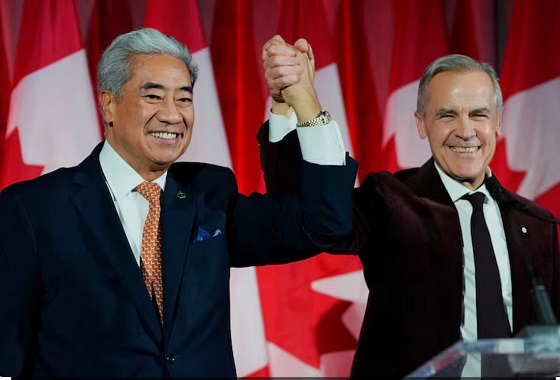
 Fly Straight - John Ivison2 days ago
Fly Straight - John Ivison2 days agoMPs who cross the floor are dishonourable members
-

 illegal immigration1 day ago
illegal immigration1 day agoUS Notes 2.5 million illegals out and counting
-

 International1 day ago
International1 day agoTyler Robinson shows no remorse in first court appearance for Kirk assassination
-

 Energy1 day ago
Energy1 day agoCanada’s future prosperity runs through the northwest coast
-

 2025 Federal Election2 days ago
2025 Federal Election2 days agoToo Close for Comfort: Carney Floor Crosser Comes From a Riding Tainted by PRC Interference
-

 Business2 days ago
Business2 days agoHigh-speed rail between Toronto and Quebec City a costly boondoggle for Canadian taxpayers
-
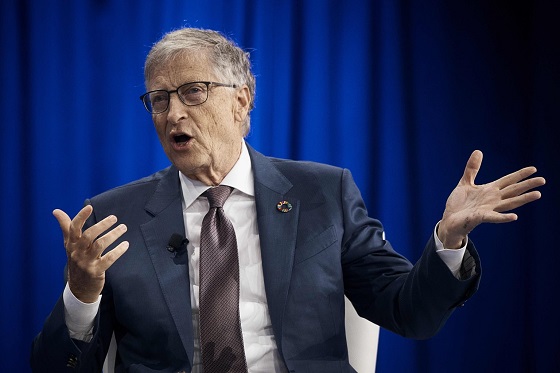
 Business2 days ago
Business2 days agoThe world is no longer buying a transition to “something else” without defining what that is



